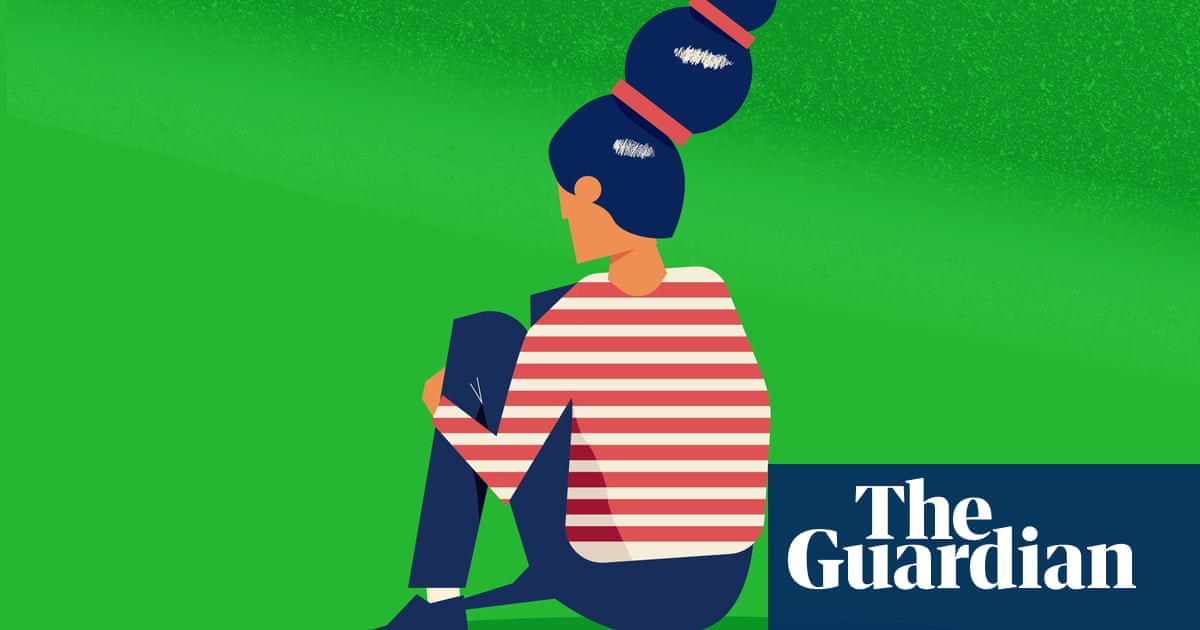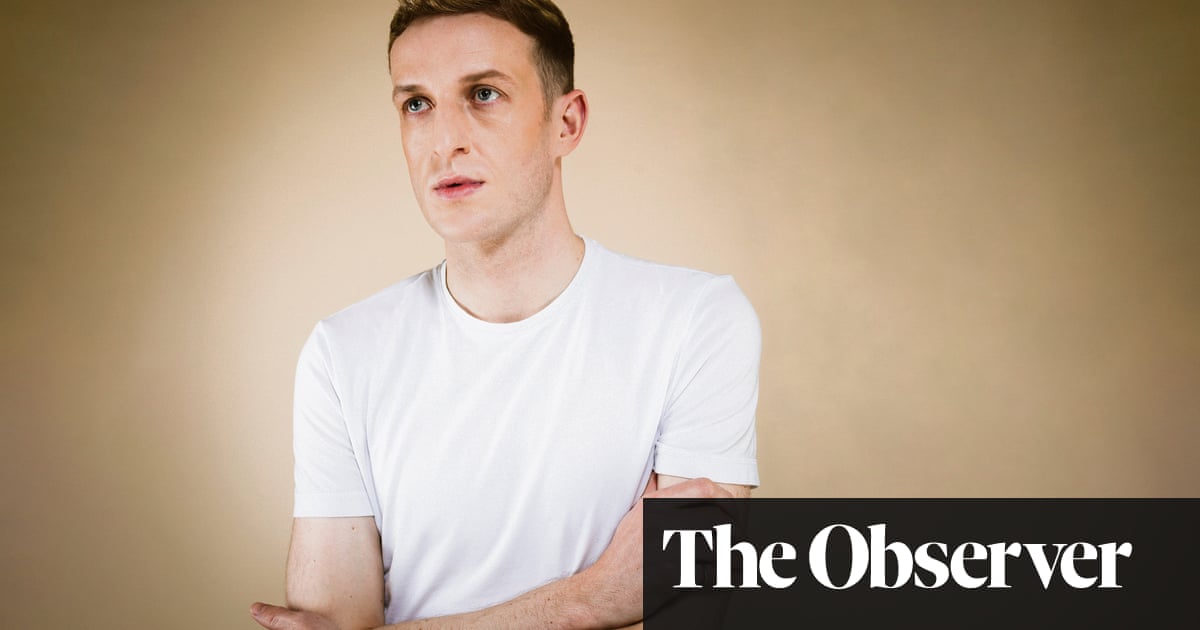
‘The best thing has been living minutes from the sea’
Shannon Moran, marine and natural history photography, Falmouth School of Art
I’ve stayed in Cornwall, where I share a house. My final project is a photo book of images created using fluorescence photography in the Red Sea. I shot it in January, and spent the rest of the term working on the layout and text.
The best thing has been living minutes from the sea; I’m hoping to start diving again soon. The hardest thing has been not being able to celebrate finishing university with my mates. I also worry I won’t be able to get a job.
‘I’m using my vintage sewing machine in the garden’
Melody Uyanga Ramsay, fashion design, Glasgow School of Art
I moved home to my family on the west coast of Scotland. I’ve been helping home school my younger siblings: treasure hunts, art lessons.
My final collection focuses on classic British tweed jackets and riding chaps/boots, inspired by my Mongolian heritage. It explores postcolonial ethics and sustainability. I’ve been using my vintage Singer sewing machine in the garden; you can hand spin, so there’s no need for electricity.
Before, I thought I knew what I wanted to achieve; now I’d like to help young people in the arts and establish my own practice.
‘I work as a delivery driver’
Sam Creasey, painting, Royal College of Art, London
Working at home in my shared flat in London has its perks: playing loud music, no commuting. But what I would achieve in a week at college takes a month at home. I’ve stopped wasting money on coffee and lunch, though.
I work as a delivery driver: I’m interested in the urban environment, and document streets and people from my van, which I turn into surreal paintings.
After graduation, I have a group show in Seattle in February 2021.
‘I set up a studio in the garage’
Robert McCormack, painting and printmaking, Glasgow School of Art
I’ve retreated to my parents’ house in Inverness, where I set up a studio in the garage. I feel lucky to have the space, even if it is a bit cold. I have continued to draw and make my own paper-pulp sculptures.
My work, which incorporates performance, drawing, sculpture and installation, explores normative behaviour and status; I’m fascinated by the role of the pet. I work as a life model to help pay for materials, and I’ve kept that up online.
When it is safe to travel, I’m heading to Florence on a research scholarship. I’m excited to explore after being stuck indoors.
‘I’ve enjoyed showing the kids what I do’
Mikey Kosela, architecture, Falmouth School of Art
I’m finishing my degree in the spare room in Cornwall. The last two months have been challenging: I have two boys, aged three and six. I’ve set up a traffic light system to let them know when they can come in, but apparently red means go and so does green.
I’m designing a multifunctional centre for life on the Isles of Scilly. I’ve taught myself new skills through necessity, producing lino prints, 3D computer models, topographical site models cast in plaster and steam-bent timber, all from home.
I’ve also enjoyed showing the kids what I do. That doesn’t mean I’m not looking forward to a pint in the pub once this is all done.
‘I’ve enjoyed the slower pace’
Zoë Ward, fashion design, Glasgow School of Art
I’m living in Glasgow with my boyfriend, Arthur, also a fashion student, and I’ve transformed our bedroom into a studio. Luckily, the tenement buildings have big rooms so we’ve managed to fit everything in: double bed, pattern-cutting table, industrial sewing machine. I feel lucky to be quarantined with someone who understands the stress of making a collection.
My work is a celebration of the traditional dress of fisherwomen across Europe and the North Sea. I’ve been trying on my garments as I don’t have a mannequin. I miss the hectic atmosphere of the art school studio, and it has been hard to stay motivated. But I’ve enjoyed the slower pace.
I feel optimistic about graduating. I was given fabric by the team at Alexander McQueen. I would love to show them my work and perhaps get some experience there. After lockdown, I’m going to cycle through the Outer Hebrides.
‘The speed at which I work has taken a hit’
Shawn Adams, architecture, Royal College of Art, London
I’ve been living with my family for four years; my parents allowed me to convert our dining table into a studio. I am restricted when it comes to large-scale drawings, and the speed at which I work has taken a hit.
My final project reconsiders the value of electronic waste in the world’s biggest digital dump – Agbogbloshie, in Ghana. Once I graduate, I aim to do community work with a collective I co-founded, POoR (Power Out of Restriction).
‘I built a makeshift darkroom’
Rachel Pendered, illustration, Falmouth School of Art
I have been silkscreen-printing patterns with hand-cut stencils in my parents’ living room in Suffolk. I built a DIY exposure unit with my dad in the shed – my makeshift darkroom.
My work involves playful images that campaign for environmental issues: encouraging people to buy secondhand clothes, plant trees, eat seasonally and cut down on plastics.
I miss working alongside my friends, but lockdown has encouraged me to be resourceful. I hope to work as an illustrator – I’d love to collaborate with ethical clothing brands, and make prints and zines.
‘I’ve created a pop-up workspace’
Ella Maiden, fine art, Falmouth School of Art
I’ve been unable to create the immersive audio/visual installations I was working on. Instead, I’ve created a pop-up workspace in my parents’ living room in Leeds to make light-sensitive cyanotype prints using objects from home – ethereal imagery that encompasses light and colour. I’ve used their red curtains to act as a dark room for the light-sensitive chemicals, and the garden to expose them in the sunlight, hanging them to dry on the washing line.
Knowing we won’t be graduating this July has been difficult; this altered end to university has been a strange one.
‘I’ve been using a creme brulee torch to solder’
Alice Fry, silversmithing and jewellery, Glasgow School of Art
I make jewellery and boxes inspired by the minerals, gemstones and rocks I collected as a child. Without GSA’s metal studio, I’ve had to be inventive: I’ve been using a creme brulee torch to solder, and vinegar to clean metal. But there’s no room for my tools, and I have no workbench.
I’ve taught myself Adobe Photoshop and Illustrator, and built myself a website from scratch. I’m at my boyfriend’s place in Yorkshire, which is wonderful – we’ve been together nearly five years, but never lived together. When lockdown lifts, I’ll head to my parents’ house in the Lincolnshire countryside, where I have a workbench in the shed.
‘I see this as beginning’
Sissel Kärneskog, fashion, Royal College of Art, London
I decided to stay in my apartment in London rather than go home to Sweden as I could have put family members at risk. Home is where I rest and reboot, so it has been difficult to work and rest with only a few square metres to move around in.
I sit on the same chair for my morning coffee, to work, and to interact with the outside world. My work explores the customisation of the non-binary body, and the interactions and responses that body will receive.
When my journey at the Royal College of Art is over, I’ll give myself time to heal. I will move home to Sweden. It’s hard to see what the future will bring, but I do not see this as an end, only a beginning.
‘I’ve done installations on the beach and in parks’
Emily Clarke, fine art, Falmouth School of Art
I moved back to my parents’ in Cleethorpes; I’m far from Falmouth, but still close to the sea.
My work questions preconceptions of paint, looking at it as an object rather than a medium. Currently, I work wherever I can, creating at home and installing in woodlands, on the beach, in parks.
The biggest challenge has been accepting that I won’t have a physical degree show to make connections with buyers, curators, dealers. But the pandemic has challenged us to consider different ways to be creative – for me, that’s installing my work in alternative locations.












